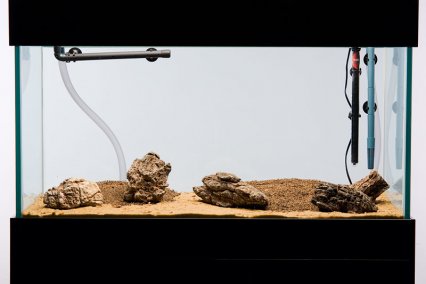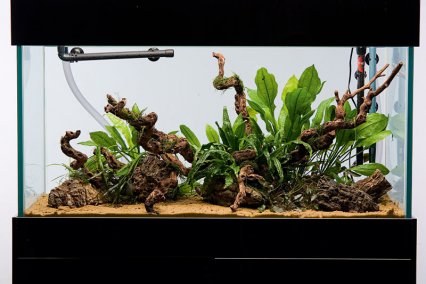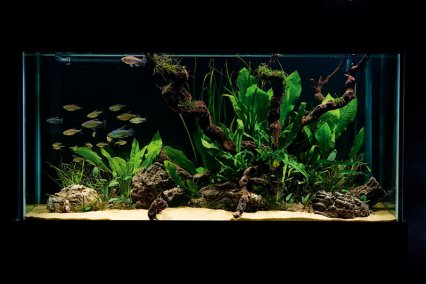Not everyone has the time, patience or finance to set up and maintain a high tech planted aquarium. Tom Messenger prepares a realistic alternative in a step-by-step guide.
Because of our changing lifestyles many prefer aquariums that demand low maintenance and can suit more modest budgets. The example set up here is designed to fit that particular bill.
The plants chosen are mainly slower growers, such as Java fern, Microsorum pteropus, Cryptocoryne sp. and Amazon swords, Echinodorus spp. With the exception of the Java fern, these also feed heavily through their root system, especially when compared with the fast-growing stem plants.
Stems will require the majority of their nutrients through the water column, because of their comparatively weak root structure, but these root feeders love a nutri ent rich substrate in which to spread their roots.
Have you ever tried to uproot a large Echinodorus? Their roots can often span the whole length of the aquarium in their search for food and are nigh on impossible to remove once they have done.
Jungle feel
Once the plants become established in this aquarium and begin to spread, it will hopefully create a nice wild, jungle feel. Bushy Cryptocoryne mingling in with the E. tenellus, with Vallisneria twisting its way through tall Echinodorus draping over the surface will create the perfect environment for our tetras.
To provide the nutritional needs of these plants, we chose standard aquatic potting soil as the substrate. This will contain many of the requirements, making them readily available to the plants’ roots.
All the plants used in this set-up, again with the exception of the E. tenellus, can be grown using only a low level of lighting. E. tenellus prefers a higher amount of light, but will be fine under medium lighting.
A very general way to determine the light requirements of individual plant species lies in leaf formation. Plants with wide, darker green leaves will often cope better in lower light than those with thin, light green or even red coloration.
The tank, which has been created by Aquariums Ltd., is a nice size and design for aquascaping.
At 100 x 45 x 45cm/39 x 18 x 18" it provides plenty of room front to back for positioning hardscape and also for planting.
The glass on this model is thick and strong, with no stress bars. This one comes with an Opti White front pane, a low iron glass that is exceptionally clear.
How to set up the aquarium

1. I chose aquatic soil as the planting substrate. It is great for lower tech tanks and allows plants easy access to nutrients. It is also cheap when compared to commercially-prepared substrates, so suiting lower budgets. I pile it into two mounds at each end of the aquarium where most plants will be placed.

2. The foreground substrate is fine sand from Unipac. It should provide a nice bright look to the front of the layout and contrast nicely with the gravel in the planted areas. To separate sand and gravel areas, make partitions out of card to keep each section in place.

3. Next in is the gravel, chosen to be able to cover the soil substrate, holding it down and preventing it from leeching through and clouding the water column. Once both sand and gravel sections are in place, carefully remove the partitions. Ensure both sides of the card partition are level to prevent spillage from one to the other.

4. To cover the filtration aspect in this tank, I use a Rena XP4. It is way over-rated for this size of tank so should be very efficient, both mechanically and biologically. The heater is positioned next to the inlet, to ensure the heat is well distributed throughout the aquarium.

5. Before rocks can be positioned, make sure that they are clean, and free of contaminants. Once in the aquarium, I make sure they are pushed well into the gravel and secure. The last thing you want is for a fish to burrow underneath and for the rockwork to collapse.

6. The wood can be laid in place wherever seems best to you. Mine floats, as it hasn’t been soaked before use, so fishing line secures pieces to rocks. When doing this at home, floating wood should be soaked in a container until it sinks. This can also remove any unwanted tannins that may leach into the water.

7. I find it easiest to secure the plants such as Microsorum onto wood before planting up the rest of the tank. Find a suitable place and tie them to wood using fishing line or cotton. Line can be removed once the plants are established, but cotton should disintegrate over time.

8. I opt for having a mainly open foreground in this set-up and the plants come from Maidenhead Aquatics in Crowland, near Peterborough. The plant scheme for the foreground consists of some small Crypt wendtii and some larger than expected E. tenellus.

9. Moving towards the mid section of the aquarium, I plant some of the larger Crypt wendtii, as well some more E. tenellus and a couple of other Echinodorus spp. The wendtii will eventually create a perimeter around the E. tenellus once it becomes established.

10. Taller Echinodorus spp. are added in the background to give it some height. Some Vallisneria spp. was also planted among the swords and should eventually grow up to and trail over the surface of the tank. The Vallis should also spread using its runners, and thicken out and enhance the jungle feel we aimed for.

11. I choose ten Lemon and ten Congo tetras. They will complement each other nicely and should fit with the style of the aquascape. There is plenty of open space which the Congos in particular should enjoy; along with plenty of cover should it be needed. The fish were loaned, with thanks, from Maidenhead Aquatics in Crowland, Peterborough.
Factfiles

Common name: Lemon tetra.
Scientific name: Hyphessobrycon pulchripinnis.
Origin: South America.
Size: 4cm/1.5”.
Aquarium: Minimum 60 x 30 x 30cm/24 x 12 x 12” with some plant cover.
Water conditions: 24-27°C/75-80°F; pH 6-7.8.
Notes: This is a lovely little fish that really shows its best colours once it has settled into the aquarium. A group of five or more is recommended.

Common name: Congo tetra.
Scientific name: Phenacogrammus interruptus.
Origin: Africa, Congo Democratic Republic.
Size: Up to 10cm/4”.
Aquarium: Minimum 90 x 38 x 38cm/36 x 15 x 15”, preferably larger; moderately to well planted, but with some open spaces for swimming.
Water conditions: 24-27°C/75-80°F; pH6-7.8.
Notes: A beautiful, showy fish and good examples look spectacular. Easy to feed, but they do like good water quality. Don’t keep this fish with tank mates that have fin-nipping tendencies. Keep a group of at least four. Males have elongated dorsal and caudal fins and are more colourful than the females.

Common name: Java fern.
Scientific name: Microsorum pteropus.
Origin: South-East Asia.
Height: To 30cm/12”.
Lighting: Low to moderate.
Water conditions: 18-30°C/64-86°F and not fussy about water chemistry.
Notes: This undemanding, slow-growing plant will tolerate a wide range of conditions. It shouldn’t be planted in the substrate but attached to bogwood or other décor using fishing line or cotton.
Expert fishkeeping advice every month – subscribe to Practical Fishkeeping and get your first three issues for just £1 each, plus get a FREE Aquarium Masterclass Guide.







